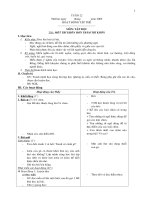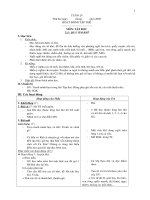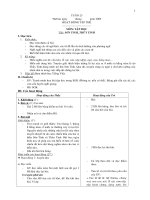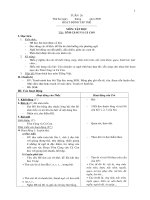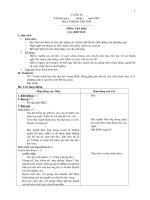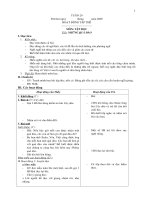giáo án bộ xử lý CPU(tin hoc)
Bạn đang xem bản rút gọn của tài liệu. Xem và tải ngay bản đầy đủ của tài liệu tại đây (1.15 MB, 29 trang )
Bộ xử lý trung tâm CPU
(Central Processing Unit )
Tạm dịch là đơn vị xử lý trung tâm
Có thể được xem như là não bộ của máy tính
Một trong những phần tử cơ bản nhất của máy tính
Nhiệm vụ: Xử lý các chương trình trong bộ nhớ
Chương trình gồm có Lệnh và Số liệu
Lệnh được bộ xử lý trung tâm (CPU) giải mã để biết
cách thức xử lý số liệu
Có nhiều kiểu dáng khác nhau qua nhiều thế hệ khác
nhau
Đặc trưng cơ bản:
Tốc độ xung nhịp
Bộ nhớ Cache
Số Pixel Pipeline
Bộ xử lý trung tâm CPU
(Central Processing Unit )
các bộ phận chủ yếu sau:
Bộ điều khiển (CU: Control Unit): Lấy lệnh từ bộ nhớ,
giải mã lệnh.
Bộ số học và luận lý (ALU: Arithmetic Logic Unit): Thực
hiện các phép tính số học và luận lý.
Các thanh ghi (Register): Bộ nhớ tốc độ cao, dung
lượng nhỏ dùng dể lưu trữ các kết quả tạm thời và các
thông tin điều khiển.
Bộ xử lý trung tâm thực hiện một chương trình bằng
cách lặp lại các bước sau :
Đọc lệnh từ bộ nhớ.
Giải mã lệnh & đọc toán hạng (nếu có)
Thực hiện lệnh
Thâm nhập bộ nhớ (nếu lệnh yêu cầu)
Ghi kết quả (nếu lệnh yêu cầu).
Bộ xử lý trung tâm CPU
(Central Processing Unit )
các bộ phận chủ yếu :
Bộ điều khiển
ALU
Các thanh ghi
Bộ xử lý trung tâm CPU
(Central Processing Unit )
Cấu trúc CPU :
B
Ộ
Đ
I
Ề
U
K
H
I
Ể
N
Thanh ghi
lệnh (IR)
Các thanh ghi đa dụng
Các toán hạng
ALU
Cờ
Thanh ghi đoạn
(Segment Register)
Thanh ghi đếm lệnh
(PC)
Kiểm soát Bus và
Phát địa chỉ
Đuôi lệnh
Bus đa hợp
EU BIU
Các loại CPU
Có nhiều loại CPU qua các thế hệ CPU như CPU 80xxx,
cyrix, AMD, Pentium MMX, Pentium Pro, pentium I, II,
III, IV, Celeron D, Xeon,
What is a personal computer processor?
The single processor chip found in personal
computers
Sometimes called a microprocessor
Processors identified by
• Manufacturer
• Model name or
model number
Pentium
®
4
Celeron™
Duron™
Athlon™
•
Who are the personal computer processor
manufacturers?
•
Note: Apple Computer, Inc began using Intel microprocessors in 2005
Intel
Pentium
®
Pentium
®
II
with
MMX™
Celeron™
Xeon™
Itanium™
Used in PCs
AMD
(Intel-
compatible)
Duron™
AMD-K6
®
Athlon™
with 3DNow!
™
Used in PCs
Motorola
PowerPC
Used in
Apples,
MACs
Alpha
Used in
workstations
and high-end
servers
•
What are the guidelines for selecting a
processor?
Microprocessor
Microprocessor
s
s
Microprocessors
Microprocessors
•
A microprocessor is a small calculating device
usually used in our home PCs which can easily fit in
the palm of your hand. A microprocessor can do
million of calculations in a blink of an eye.
Devices with microprocessors
Devices with microprocessors
Nowadays microprocessors are found almost in
every thing that uses electricity to operate.
Microprocessors Companies
Microprocessors Companies
•
There are many microprocessor companies
in market
•
but the two well recognized are Intel and
AMD
•
(Advance Micro Devices).
Processor
Processor
Control
Control
Unit
Unit
Arithmetic
Arithmetic
Logic Unit (ALU)
Logic Unit (ALU)
Arithmetic
Arithmetic
Logic Unit (ALU)
Logic Unit (ALU)
•
What is the central processing unit
(CPU)?
Input
Input
Devices
Devices
Storage
Storage
Devices
Devices
Output
Output
Devices
Devices
Interprets and carries out basic instructions that
operate a computer
Memory
Memory
Data
Data
Information
Information
Information
Information
Data
Data
Information
Information
Information
Information
Data
Data
Information
Information
Control
Control
Unit
Unit
Control unit directs
and coordinates
operations in computer
Arithmetic logic unit
(ALU) performs
arithmetic, comparison,
and logical operations
Also called the
processor
•
What is a machine cycle?
Processor
Control Unit
Memory
ALU
Step 1. Fetch
Obtain program instruction or
data item from memory
Step 2.
Decode
Translate
instruction into
commands
Step 4. Store
Write result to memory
Step 3. Execute
Carry out command
Four operations of the CPU comprise a machine cycle
•
What is pipelining?
p. 4.07 Fig. 4-7
CPU begins fetching second instruction before completing
machine cycle for first instruction
Results in faster processing
•
What is a register?
Stores location
Stores location
from where instruction
from where instruction
was fetched
was fetched
Stores
Stores
instruction while it is
instruction while it is
being decoded
being decoded
Stores data
Stores data
while ALU
while ALU
computes it
computes it
Stores results
Stores results
of calculation
of calculation
Temporary high-speed storage area that holds
data and instructions [Data registers, Instruction
registers, Address registers, etc]
•
What is the system clock ?
[Not the real-time clock!]
Each tick
Each tick
is a
is a
clock cycle
clock cycle
Pace of system
Pace of system
clock is
clock is
clock speed
clock speed
Most clock speeds are
Most clock speeds are
in the gigahertz (GHz)
in the gigahertz (GHz)
range (1 GHz = one
range (1 GHz = one
billion ticks of system
billion ticks of system
clock per second)
clock per second)
Processor speed can
Processor speed can
also be measured in
also be measured in
m
m
illions of
illions of
i
i
nstructions
nstructions
p
p
er
er
s
s
econd
econd
(MIPS)
(MIPS)
Controls timing of all computer operations
Generates regular electronic pulses, or ticks, that set
operating pace of components of system unit
Overclocking a Microprocessor
•
Overclocking is the process of making your computer
•
run faster than it was when you first bought it.
•
Warning: Don’t do this if you a Pentium 4 w/HT because
•
you will burn up the processor !
•
If you bought a Pentium 4 running at 3.2 GHz and you
•
want it to run faster, you could overclock the processor
•
to make it run at 3.6 GHz.
Microprocessors: Which one ?
•
Which processor should you select?
The faster the processor, the more expensive the computer
Celeron
Itanium or Xeon
Pentium family
1.3 GHz
and up
3.0 GHz
and up
2.4 GHz to
3.0 GHz
Up to 2.4
GHz
2.2 GHz
and up
Intel Processor Desired
Clock Speed
Microprocessors from the Recent Past
•
How do personal computer processors compare?
Comparison of Widely Used
Personal Computer Processors
Name Date ClockIntroduced Speed
Itanium 2 2002 1.3–1.5 GHZ
Xeon 2001 1.4–3.06 GHZ
Itanium 2001 733–800 MHZ
Pentium 4 2000 1.4–3.2 GHZ
Pentium III Xeon 1999 500–900 MHZ
Pentium III 1999 400 MHZ–1.4 GHZ
Celeron 1998 266 MHZ–2.6 GHZ
Operon 2003 2–2.4 GHZ
Athlon MP 2002 1.53–2.25 GHZ
Athlon XP 2001 1.33–2.26 GHZ
Athlon 1999 500 MHZ–1.4 GHZ
™
•
What is a zero-insertion force (ZIF) socket?
Step 2.
Insert the
chip.
Step 1.
Lift the lever on
the socket.
lever
Step 3.
Push the lever
down.
lever
Allows you to install and remove chips with no force
•
What are heat sinks and heat pipes?
Heat sink—component
with fins that cools
processor
heat sink fan
heat sink
Heat pipee—smaller
device for notebook
computers
•
What are heat sinks, heat pipes, and liquid
cooling?
Heat sink — component with fins that cools processor
Heat pipee—smaller
device for notebook
computers
Liquid cooling—
uses a continuous
flow of fluids to
transfer heat away
•
What is parallel processing?
Control Processor
Control Processor
Processor 1
Processor 1
Memory
Memory
Processor 2
Processor 2
Memory
Memory
Processor 3
Processor 3
Memory
Memory
Processor 4
Processor 4
Memory
Memory
Results combined
Using multiple processors simultaneously to execute a
program faster
Requires special software to divide problem and bring
results together
Sockets supporting Intel processors
Socket 6 - 80486DX4
Socket 7 - Intel Pentium and Pentium MMX, AMD K6
and some Cyrix CPUs)
Socket 8 - Intel Pentium Pro
Slot 1 - Intel Pentium II, older Pentium III, and
Celeron processors (233 MHz - 1.13 GHz)
Slot 2 - Intel Xeon processors based on Pentium II/III
cores
Socket 370 - Celeron processors and newer
Pentium IIIs (800 MHz - 1.4 GHz)
Socket 423 - Intel Pentium 4 and Celeron processors
(based on the Willamette core)


